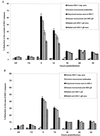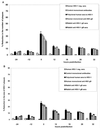Neutralizing antibodies inhibit axonal spread of herpes simplex virus type 1 to epidermal cells in vitro
- PMID: 10364346
- PMCID: PMC112655
- DOI: 10.1128/JVI.73.7.5934-5944.1999
Neutralizing antibodies inhibit axonal spread of herpes simplex virus type 1 to epidermal cells in vitro
Abstract
The ability of antibodies to interfere with anterograde transmission of herpes simplex virus (HSV) from neuronal axons to the epidermis was investigated in an in vitro model consisting of human fetal dorsal root ganglia innervating autologous skin explants in a dual-chamber tissue culture system. The number and size of viral cytopathic plaques in epidermal cells after axonal transmission from HSV type 1 (HSV-1)-infected dorsal root ganglionic neurons were significantly reduced by addition to the outer chamber of neutralizing polyclonal human sera to HSV-1, of a human recombinant monoclonal group Ib antibody to glycoprotein D (gD), and of rabbit sera to HSV-1 gB and gD but not by rabbit anti-gE or anti-gG. A similar pattern of inhibition of direct infection of epidermal cells by these antibodies was observed. High concentrations of the monoclonal anti-gD reduced transmission by 90%. Rabbit anti-gB was not taken up into neurons, and human anti-gD did not influence spread of HSV in the dorsal root ganglia or axonal transport of HSV antigens when applied to individual dissociated neurons. These results suggest that anti-gD and -gB antibodies interfere with axonal spread of HSV-1, possibly by neutralizing HSV during transmission across an intercellular gap between axonal termini and epidermal cells, and thus contribute to control of HSV spread and shedding. Therefore, selected human monoclonal antibodies to protective epitopes might even be effective in preventing epidermis-to-neuron transmission during primary HSV infection, especially neonatal infection.
Figures








Similar articles
-
Alpha and gamma interferons inhibit herpes simplex virus type 1 infection and spread in epidermal cells after axonal transmission.J Virol. 2001 Dec;75(23):11821-6. doi: 10.1128/JVI.75.23.11821-11826.2001. J Virol. 2001. PMID: 11689663 Free PMC article.
-
Axonal transport of herpes simplex virions to epidermal cells: evidence for a specialized mode of virus transport and assembly.Proc Natl Acad Sci U S A. 1994 Jul 5;91(14):6529-33. doi: 10.1073/pnas.91.14.6529. Proc Natl Acad Sci U S A. 1994. PMID: 7517552 Free PMC article.
-
Cell-to-Cell Spread Blocking Activity Is Extremely Limited in the Sera of Herpes Simplex Virus 1 (HSV-1)- and HSV-2-Infected Subjects.J Virol. 2019 May 15;93(11):e00070-19. doi: 10.1128/JVI.00070-19. Print 2019 Jun 1. J Virol. 2019. PMID: 30867302 Free PMC article.
-
Patient-Specific Neutralizing Antibody Responses to Herpes Simplex Virus Are Attributed to Epitopes on gD, gB, or Both and Can Be Type Specific.J Virol. 2015 Sep;89(18):9213-31. doi: 10.1128/JVI.01213-15. Epub 2015 Jun 24. J Virol. 2015. PMID: 26109729 Free PMC article.
-
Anterograde transport of α-herpesviruses in neuronal axons.Virology. 2021 Jul;559:65-73. doi: 10.1016/j.virol.2021.02.011. Epub 2021 Mar 4. Virology. 2021. PMID: 33836340 Review.
Cited by
-
Alpha and gamma interferons inhibit herpes simplex virus type 1 infection and spread in epidermal cells after axonal transmission.J Virol. 2001 Dec;75(23):11821-6. doi: 10.1128/JVI.75.23.11821-11826.2001. J Virol. 2001. PMID: 11689663 Free PMC article.
-
Anterograde transport of herpes simplex virus type 1 in cultured, dissociated human and rat dorsal root ganglion neurons.J Virol. 2000 Feb;74(4):1827-39. doi: 10.1128/jvi.74.4.1827-1839.2000. J Virol. 2000. PMID: 10644356 Free PMC article.
-
Vaccine-induced serum immunoglobin contributes to protection from herpes simplex virus type 2 genital infection in the presence of immune T cells.J Virol. 2001 Feb;75(3):1195-204. doi: 10.1128/JVI.75.3.1195-1204.2001. J Virol. 2001. PMID: 11152492 Free PMC article.
-
Herpes simplex virus type 1 glycoprotein E domains involved in virus spread and disease.J Virol. 2000 Aug;74(15):6712-9. doi: 10.1128/jvi.74.15.6712-6719.2000. J Virol. 2000. PMID: 10888608 Free PMC article.
-
A caprine herpesvirus 1 vaccine adjuvanted with MF59™ protects against vaginal infection and interferes with the establishment of latency in goats.PLoS One. 2012;7(4):e34913. doi: 10.1371/journal.pone.0034913. Epub 2012 Apr 12. PLoS One. 2012. PMID: 22511971 Free PMC article.
References
-
- Biron C A, Byron K S, Sullivan J L. Severe herpesvirus infections in an adolescent without natural killer cells. N Engl J Med. 1989;320:1731–1735. - PubMed
-
- Brown Z A, Benedetti J, Ashley R, Burchett S, Selke S, Berry S, Vontver L A, Corey L. Neonatal herpes simplex virus infection in relation to asymptomatic maternal infection at the time of labor. N Engl J Med. 1991;324:1247–1252. - PubMed
-
- Burlet A J, Menzaghi F, Tilders F J, Oers J W, Nicholas J P, Burlet C R. Uptake of monoclonal antibody to corticotropin-releasing factor (CRF) into rat hypothalamic neurons. Brain Res. 1990;28:283–293. - PubMed
-
- Corey L, Adams H G, Brown Z A, Holmes K K. Genital herpes simplex virus infection: clinical manifestations, course and complications. Ann Intern Med. 1983;98:958–972. - PubMed
Publication types
MeSH terms
Substances
Grants and funding
LinkOut - more resources
Full Text Sources
Other Literature Sources
Miscellaneous

